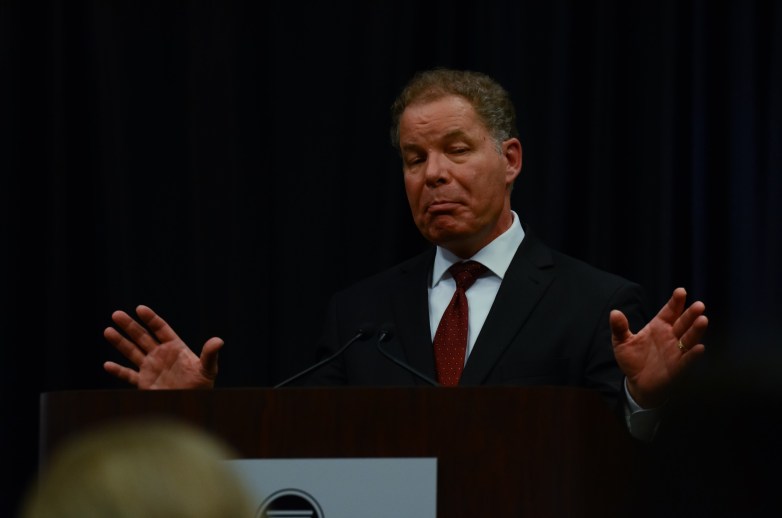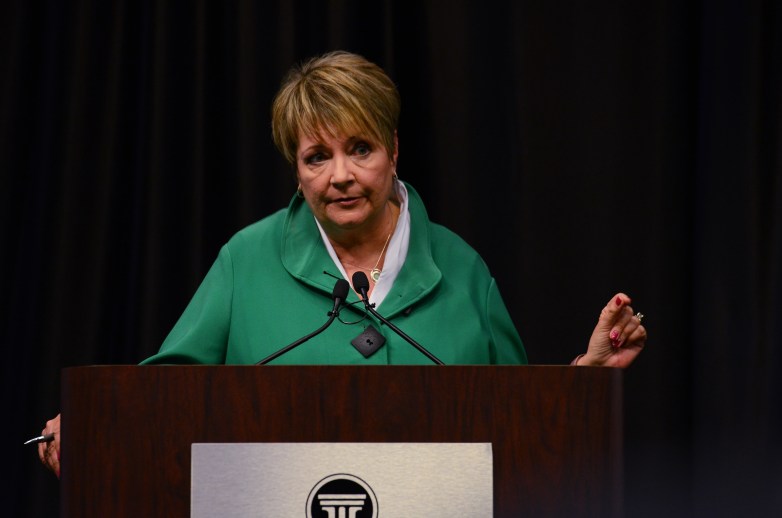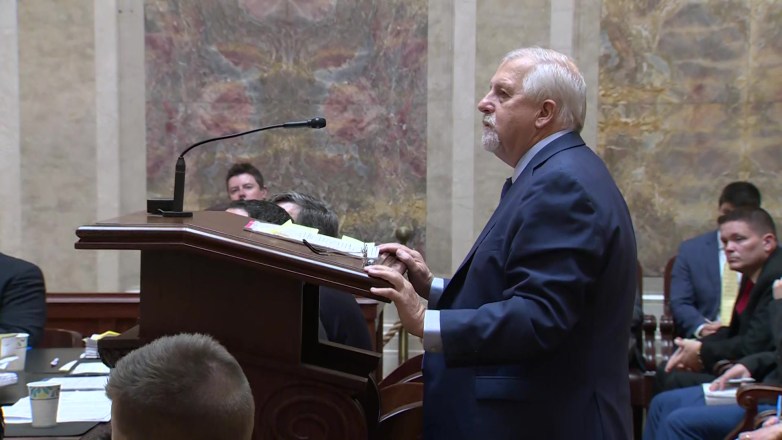The Wisconsin Supreme Court is more divided than ever.
Last year, the court issued more decisions with a “fractured opinion” than in any of the past 25 years, according to a review of Marquette University Law School research.
“Back in the 1950s (and even earlier), the Justices regularly issued unanimous or near-unanimous decisions in almost all of their cases,” attorneys Jeffrey Mandell and Daniel Schneider wrote in a draft article they shared with Wisconsin Watch. “Today, that happens less than half of the time.”

Fractured opinions occur when the majority agrees on the outcome of a case, but can’t articulate a unified basis for reaching its conclusion. That results in multiple, often lengthy, concurrent opinions and dissents that draw different configurations of support from the seven justices. Such decisions often leave the state without clear guidance on what the law is.
Nine of the court’s 52 decisions in 2022 were fractured — more than twice as many as a decade ago and far more than 20 years ago when the court issued 89 rulings in one year without a single fracture, according to Mandell and Schneider, who reviewed research by Marquette University history Professor Alan Ball. Mandell is board president of Law Forward and Schneider works for Legal Action Chicago, both liberal legal advocacy groups.
“It’s not an overstatement that the Wisconsin Supreme Court has been dysfunctional for quite some time now,” Marquette University Law School Professor Chad Oldfather said at a recent Scholars Strategy Network of Wisconsin panel discussion about the Supreme Court election.
“There’s interpersonal conflict that goes back to the 1990s. The partisanship has given it a different dimension, but the conflict isn’t new. This is all situated within this larger framework of partisan discord that characterizes state politics here.”
The recent trend of more fractured opinion cases is worth noting ahead of the upcoming Wisconsin Supreme Court contest. Such cases spotlight which matters the court could more easily revisit if liberal Milwaukee County Judge Janet Protasiewicz defeats conservative former Supreme Court Justice Dan Kelly for the 10-year seat being vacated by retiring conservative Justice Patience Roggensack.

The April 4 election has mostly been framed as a referendum on major political issues including the state’s 1849 abortion ban and the Republican-gerrymandered legislative districts.
But the possibility that the ideological composition of the majority could shift 15 years of conservative control to four liberal justices has implications for other cases that could come before the court — ranging from ballot drop boxes and public sector union rights to the results of the 2024 presidential election.
‘Everything … may be revisited’
Liberals wrote several majority opinions from 2004 to 2008 after Democratic Gov. Jim Doyle appointed Louis Butler Jr. to replace conservative Justice Diane Sykes, who left after being appointed to the U.S. Court of Appeals. During that time, liberals controlled three seats and were often joined by a swing justice in decisions that conservatives decried as “liberal activism.”
But in 2008, Butler lost the election to Michael Gableman, ushering in an era in which conservatives mostly dominated the court. Since then, there have been more than 100 decisions in which the court’s liberals have dissented.
They include rulings that upheld restrictions on public sector collective bargaining, allowed guns on public buses, upheld a $750,000 cap on medical malpractice damages and strengthened legislative control over the executive branch, among others.

Protasiewicz has made no secret of the likelihood that her election would result in many decisions from the conservative era being revisited. The court has not ruled on abortion, but the recent U.S. Supreme Court decision overturning Roe v. Wade and a pending lawsuit challenging the state’s 1849 abortion ban means it will be one of the biggest issues before the court in the next term.
“Everything from gerrymandering to (ballot) drop boxes to Act 10 may be revisited to women’s right to choose,” she told Wisconsin Radio Network. “No matter where you fall politically, you want someone who is going to look at those cases and render decisions that are fair and impartial.”
Kelly has sounded the alarm that the power of the Legislature — which Republicans control with gerrymandered maps that the conservative Supreme Court has sustained — hangs in the balance.
“If there is an activist majority, (voters) will lose their ability to have their public policy set by their legislators,” Kelly told Wisconsin Radio Network. “They’re afraid that there will be four lawyers sitting in a Madison courtroom dictating policy decisions to the entire state.”
A return to ‘regular order’
Rick Esenberg, president of the conservative Wisconsin Institute for Law and Liberty, said a liberal majority could mean a return to the kinds of decisions from the 2004-05 term when Butler was on the court.
Conservatives decried several of those decisions as “judicial activism,” including one that allowed manufacturers to be held liable in lead paint poisoning cases, another that struck down the state’s cap on medical malpractice damages and one in which the court struck down a conviction based on social science evidence that victim identification of a suspect at a crime scene was unreliable.
“It is a principle of the progressive left legal tradition that language is indeterminate … and this tends to increase the discretion the justices have,” Esenberg said. “Virtually any case could be on the radar screen.”
Sachin Chheda, a Democratic political strategist and adviser to Protasiewicz’s campaign, acknowledged that a Protasiewicz win could lead to the court tossing out the 1849 abortion ban and the current legislative maps.

But he disputed that there would be a wholesale attempt to toss out precedent and rewrite existing laws, such as the controversial 2011 Act 10, which hobbled public sector labor unions.
“The first thing we’ll see (if Protasiewicz wins) is some form of return to regular order,” Chheda said at the Scholars Strategy Network panel. “I don’t think anyone expects that the court is going to immediately take up 15 cases.”
When Protasiewicz applied to Republican Gov. Scott Walker to be a Milwaukee County Circuit Court judge in 2012 she listed one of the 2005 cases, State v. Dubose — which wrote new rules for suspect identification — as one of the worst in the past 30 years because it “hampered law enforcement … resulting in denial of justice to the victim.”
Former state Supreme Court Justice Janine Geske, a citizen member of the Wisconsin State Journal editorial board that endorsed Protasiewicz, said a return to “regular order” would mean justices respecting precedent and not giving deference to the political implications of cases.
Geske described herself as a judicial conservative during her time on the court, but noted that definition has historically been distinct from a political conservative. She said judicial conservatives tend to rule on cases as narrowly as possible.
“You shouldn’t be making big policy decisions in a case that doesn’t call for it,” she said.
Fractured decisions could be revisited
Some of the major Wisconsin Supreme Court decisions in recent years affecting how state government works have come through fractured opinions, Mandell said in an interview. That’s significant because it creates a greater possibility that the issue will be litigated again if the court flips to liberal control.

For example, in Bartlett v. Evers, a challenge to Gov. Tony Evers’ partial veto power in the 2019-21 budget, the court found three of the vetoes were unconstitutional and one was constitutional, but noted “no rationale has the support of a majority.”
“The Bartlett case doesn't tell us in any meaningful sense when a line-item veto by the governor or partial line-item veto by the governor is constitutional and when it's not,” Mandell said. “The result of that is not just that the issue remains ripe for litigation again, but the result is also that now that it's budget season neither the governor nor the Legislature has any idea how to handle the budget in a way that doesn't raise this issue again.”
There’s already precedent for a fractured case being overturned by a change in court personnel.
In 2016, the court in the 4-3 fractured decision Coyne v. Walker upheld the Department of Public Instruction’s ability to set administrative rules without legislative oversight. But only the two liberal justices in the majority affirmed a precedent-setting decision 20 years earlier that DPI’s authority is established in the state constitution.
After Kelly was appointed to replace retiring Justice David Prosser, who had been in the Coyne majority, another case was brought challenging DPI’s authority, Koschkee v. Taylor, and the court ruled 4-3 with Kelly in the majority to reverse Coyne.
In a 2018 unanimous, but fractured, decision, Tetra Tech EC, Inc. v. Wisconsin Department of Revenue, Kelly wrote a 7-0 decision that agreed with the state that companies cleaning up contamination in the Fox River had to pay a sales tax. But only one other justice agreed with Kelly that the decision was based on the constitutional separation of powers.
Mandell and Schneider said the way the decision mixed 50 paragraphs with majority support among 58 paragraphs lacking majority support “has created confusion for lower courts and others trying to decipher the law.”
Among last year’s record number of fractured cases was Friends of Frame Park v. City of Waukesha. In a 4-3 decision, the court’s conservative majority led by Justice Brian Hagedorn determined that a group could not claim attorney’s fees in a public records lawsuit primarily because the city of Waukesha was correct in withholding the record until it was eventually released.
However, the three conservative members, without Hagedorn, additionally ruled that the law doesn’t allow for attorney’s fees if the government releases the records before a court order.
Public records advocates argued the decision will make it easier for governments to withhold records, and district judges have already denied fee recovery requests using the logic of the three-judge concurrence. But because the decision was fractured, a future court might reverse.
Mandell and Schneider conclude that the increasing inability of the court to clarify the law "is not only disappointing but also damaging to (the court) as an institution and to Wisconsin law.”
Editor's note: This story was updated to include more information about Mandell's and Schneider's backgrounds.
The nonprofit Wisconsin Watch (www.WisconsinWatch.org) collaborates with WPR, PBS Wisconsin, other news media and the University of Wisconsin-Madison School of Journalism and Mass Communication. All works created, published, posted or disseminated by Wisconsin Watch do not necessarily reflect the views or opinions of UW-Madison or any of its affiliates.
This article first appeared on Wisconsin Watch and is republished here under a Creative Commons license.![]()



